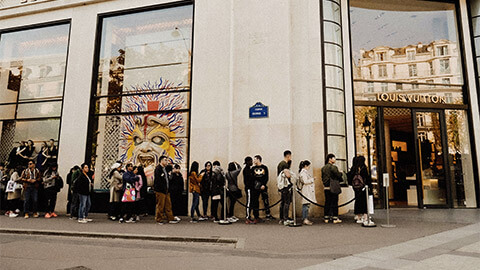One of the most important considerations for a service organisation, given its perishability and relatively fixed capacity, is managing fluctuations in service demand. The two (2) key levers at our disposal to navigate capacity and demand are marketing strategies – namely, price and adjusting capacity/supply. We discussed fluctuating demand previously as part of the service pricing strategy in Topic 6. However, it deserves further attention as it is one of the significant challenges for service organisations to overcome.
Welcome to Topic 8: Balancing Capacity and Demand. In this topic, you will learn about:
- What is meant by productive capacity in a service context
- Capacity management techniques to meet variations in demand
- Patterns and determinants of demand for different customer segments
- The various supply-demand situations that service firms with fixed capacity may face
- The five (5) basic demand management strategies and techniques
- The marketing mix elements that reduce fluctuations in demand
- The psychology of waiting and its implications for designing queuing systems
- The importance of reservations systems for inventory demand.
These relate to the Subject Learning Outcomes:
- Discuss the key concepts, principles and unique challenges of services marketing in relation to the extended marketing mix.
Welcome to your pre-seminar learning tasks for this week. Please ensure you complete these prior to attending your scheduled seminar with your lecturer.
Click on each of the following headings to read more about what is required for each of your pre-seminar learning tasks.
Read Chapter 7 of the prescribed text - Lovelock et al. 2014, Marketing in the service economy, 6th edn., Pearson Australia.
Watch the following video:
Visit the Australian Government website and watch the short video that explains National Disability Insurance Scheme (NDIS) demand mapping. This is an example of how the government informs organisations of the NDIS demand throughout Australia, allowing them to develop new services and offerings in high-demand areas. Think about how the demand and supply concepts discussed in this topic could be implemented in the public health sector to better cater to those utilising the NDIS funding.
Read the following two (2) case studies:
- 'Demand variations and efficiency – are they compatible?' on p. 195 of the prescribed text.
- 'Managing capacity and demand at a yoga centre' on p. 215 of the prescribed text.
Read and watch the following content.

Defining productive capacity
Productive capacity is the idea of how to most effectively utilise an organisation’s resources to provide a service (Lovelock et al. 2014). Successful service organisations seek to optimise their time and productive capacity while mitigating any bottlenecking when demand is too high. Productive capacity is not always about maximising resource use as much as possible but about smoothing fluctuations in demand and supply, catering to valuable customers (those willing to pay a higher price or those who are loyal), and maintaining high customer service.
Lovelock et al. (2014, p. 193) describe five (5) forms of productive capacity in a service context:
- Physical facilities designed to contain customers (for example, medical clinics, hotels and classrooms)
- Physical facilities designed for storing or processing goods (for example, warehouses, parking lots and pipelines)
- Physical equipment used to process people, possessions or information (for example, airport security and ATMs)
- Labour (for example, staffing at a restaurant, medical clinic, law firm and IT support)
- Infrastructure (for example, relieving air and road traffic congestion, improving nearby parking and road access).
Managing capacity
There are two (2) key categories of capacity management techniques that services organisations can leverage to meet demand fluctuations:
- Stretch or shrink existing capacity levels (Lovelock et al. 2014, p. 194)
- Some capacity limits are elastic; levels can be stretched to a certain extent with no actual capacity modification. However, stretched capacities are not sustainable and often have detrimental effects on customer experience. For example, imagine travelling on a normal capacity versus a packed train or going to an overcapacity restaurant where it takes a very long time to place an order.
- Capacity can also be stretched through extending hours in response to high demand.
- Alternatively, capacity can be stretched by reducing the average time spent serving each customer. Restaurants provide various great examples of this; staff being diligent with providing menus, taking orders and providing the bill can all reduce the overall time the customer spends in the restaurant. Further, set menus can be utilised during busy periods or for large groups to reduce the level of service required.
- Adjusting capacity to match demand (also called chasing demand) (Lovelock et al. 2014, p. 196)
- Downtime can be scheduled during periods of low demand (schedule repairs, maintenance, employee holidays, updates for low demand periods).
- Employees can be cross-trained so the same employee can pivot to different tasks at moments of changing demand.
- Alternatively, casual and part-time employees can be brought on to increase staffing during peak periods, such as Christmas.
- Customers can have the option to perform self-service (co-production) if employee capacity is limited, which is commonly seen at supermarket self-check-outs.
- Customers could also be asked to share the service. For example, asking customers to share a large table at a café or share a taxi from the airport
- There are also infrastructure modifications that can create flexible capacity. For example, hotels with adjoining rooms can sell rooms individually or as two-bedroom suites, according to demand.
- Service organisations can rent or share extra facilities and equipment such as short term space or machine rentals, or develop formal sharing agreements where businesses have complementary demand patterns (for example, ski rental and mountain bike rental).
Understanding the patterns and determinants of demand
Service organisations need to try and understand patterns of demand and their likely causes to formulate a strategy to manage capacity and/or demand. A detailed transaction history is essential for mapping demand cycles over time. There are four (4) key questions to consider regarding patterns and causes of demand (Lovelock et al. 2014, p. 197):
- Do demand levels follow a predictable cycle? If so, is the duration of the demand cycle:
- One day and varies by the hour?
- One week and varies by the day?
- One month and varies by the day or week?
- One year and varies by month, by season or reflects annual public holidays?
- Another period?
- What are the underlying causes of these cyclical variations?
- Employment schedules
- Billing and tax payment/refund cycles
- Wage and salary payment dates
- School hours and term dates
- Seasonal changes in climate
- Occurrence of public or religious holidays
- Natural cycles, such as coastal tides.
- Do demand levels seem to change randomly? If so, could the underlying causes be:
- Day-to-day changes in the weather?
- Health events whose occurrence cannot be pinpointed exactly?
- Accidents, fires and certain criminal activities?
- Natural disasters such as earthquakes, storms, mudslides and volcanic eruptions?
- Can demand for a particular service over time be disaggregated by market segment to reflect such components as:
- Use patterns by a particular type of customer or for a particular purpose?
- Variations in the net profitability of each completed transaction?
Market segmentation (point 4 above) can be a particularly helpful lens to understand demand fluctuations. Looking at segments can help unveil behavioural patterns that you may not otherwise see if you view all your customers as a collective.
For example, many cinemas offer special sessions and prices for seniors or parents with babies because they have identified that these distinct segments have different demand patterns and needs from other customers. Village Cinemas even adjust the theatre lighting in the baby-friendly sessions, so parents have greater visibility over their children during the movie (Village Cinemas Australia 2021).

In 2019, Woolworths introduced ‘Quiet Hour’ in 260 stores, catering to those who experience anxiety and sensory stress in the regular supermarket environment. During ‘Quiet Hour’, the stores lower the lights and reduce the volume of music, general PA announcements, store phone and register volume (Woolworths Group 2019). The reduced sensory input enables these shoppers to navigate the store independently and without stress.
Strategies for managing demand
Some service organisations have a fixed capacity and cannot employ the previously mentioned capacity management strategies. Instead, they must focus on strategies for managing demand. Fixed-capacity services face one (1) of four (4) conditions depending on the level of demand at the time:
- Optimum capacity
- Demand exceeds optimum capacity
- Demand exceeds maximum capacity
- Excess capacity.
The following figure depicts the levels of capacity. Let us consider this figure using the example of a cocktail bar.
Optimum capacity
Ideally, the cocktail bar wants to operate in the light green zone – optimum capacity where demand and supply are well balanced. In this situation, there are enough customers in the bar to create a great ambience and vibe; bar staff are working productively without being too busy, which means customers receive their drinks promptly and experience excellent customer service.

Demand exceeds optimum capacity
As demand increases, the cocktail bar enters the yellow zone where demand exceeds optimum capacity without exceeding maximum capacity. In this situation, bar staff are being overworked; the bar is crowded; customers have to wait longer to be served and receive their drinks; and perhaps the cocktails are not being made with the same attention to detail and customer service.
It is important to note that the presence and size of the yellow zone depend on the resources and strategies of the service organisation. In the case of a live music venue, perhaps maximum capacity is the optimum capacity (in other words, there is no yellow zone) – they want as many people as they can squeeze in! The achievement of capacity contributes to the excitement of the venue without significant reductions in service quality. However, in the case of the cocktail bar, the bar might be aiming for a quieter feel, so maximum capacity is not desirable. Given the time taken to mix a cocktail, this increased capacity is also likely to result in lower service quality due to longer waiting times for cocktails.
Demand exceeds maximum capacity
When demand exceeds maximum capacity, they enter the orange zone where new patrons are turned away or asked to line up. This results in lost business, disappointment from potential customers on top of the existing issues of crowding, overworked staff and decreased customer service quality already described in the yellow zone.
Excess capacity
At the opposite end of the spectrum, the cocktail bar could experience excess capacity – in the dark green zone – where demand is really low. Have you ever walked past a restaurant or bar and not entered because the venue was empty? The lack of customers obviously results in fewer sales but also diminishes the venue’s lively vibe, which could give the impression to potential patrons that the bar service and cocktails are of poor quality. It also means that bar staff are being underutilised and not productive.
Demand management strategies
Service organisations can employ demand management strategies to smooth these fluctuations in demand. Lovelock et al. (2014, p. 201) outline five (5) approaches and their implications according to the capacity situation as shown in the following table:
| Capacity situation | ||
|---|---|---|
| Approaches to managing demand | Insufficient capacity (excess demand) | Excess capacity (insufficient demand) |
| Take no action |
|
|
| Reduce demand |
|
|
| Increase demand |
|
|
| Inventory demand by a formalised wait and queuing system |
|
N/A |
| Inventory demand by a reservation system |
|
|

Managing waiting
The psychology of waiting in line is a fascinating phenomenon. You watched a video about waiting in line as part of your pre-seminar learning tasks. Service organisations are encouraged to consider how best to manage queues, ensuring a fast, equitable and comfortable waiting experience. Various options include (Lovelock et al. 2014, p. 206):
- Rethinking the design of the queuing system (one single snake line is preferred to multiple lines)
- Installing a reservation system (to automate the process and reduce the need for lines)
- Tailoring the queuing system to different market segments (for example, priority cues at the airport)
- Managing customers’ behaviours and their perceptions of the wait (for example, announcing flight or public transport delays, or informing restaurant patrons of delays in the kitchen)
- Redesigning processes to shorten the time needed for each transaction.
Using the marketing mix to shape demand
Businesses can also use the following four (4) elements of the marketing mix to shape demand (Lovelock et al. 2014):
- Pricing strategies
- Product variations
- Modifying timing and location of delivery
- Communication strategies.
Pricing strategies
Prices can be increased during periods of excess demand and lowered in low-demand periods. For example, businesses can offer weekday movie concessions or lower off-peak public transport travel prices to incentivise patronage, while higher accommodation rates during school holidays and Christmas may reduce demand during the popular holiday season. You may like to revisit Topic 6, where we discussed demand-based pricing strategies in detail.
Product variations
Product variation can involve using the same space for different consumer needs at different times of day or season. For example, a venue could serve food during lunch and dinner times, then be suitable for live music and dancing later in the evening, simply by removing the tables. More extreme seasonal demands can also utilise product variation to generate revenue in off-season periods. For example, a ski resort could promote mountain climbing or mountain biking in the summer months.
Modifying timing and location of delivery
Service organisations can limit their trading hours in low-demand times to reduce labour costs and increase trading hours on days or periods of high demand. For example, many retailers extend trading hours during Christmas and school holidays, and cinemas provide more movie sessions on weekends versus weekdays. Mobile services allow for flexibility in delivery locations. For example, mobile dog groomers can come to your home, and mobile health clinics can travel to regional areas to allow consumers access to the service they might not otherwise have.
Communication strategies
Service organisations can inform consumers of peak demand times and encourage early bookings or off-period times to ensure faster service and avoid disappointment. For example, public transport will often include notices for leisure travellers to avoid peak hour travel.
The previous strategies of changes to pricing, trading hours and availability, etc., can be communicated to set consumer expectations correctly.
In summary, service organisations must constantly monitor the supply and demand of their service and utilise the various levers available to them to shift capacity and/or demand. Ideally, services should perform at optimal capacity, where supply and demand are balanced. Organisations can either expand or contract their capacity limits or adjust capacity requirements to free up employees for periods of high demand. They can also leverage upon the 4Ps to shift demand and implement reservation and queuing systems to anticipate and manage demand.
Knowledge check
Complete the following two (2) tasks. Click the arrows to navigate between the tasks.
Key takeouts
And that is it for Topic 8! Here are some key takeouts:
- Service organisations need to optimise their productive capacity to be effective and profitable. For example, use their resources wisely to provide services that cater to valuable customers, while also smoothing fluctuations in demand and supply
- Capacity can be managed by stretching or shrinking existing capacity levels (although this can have negative consumer consequences) or adjusting capacity to match demand.
- Service organisations need to understand patterns in demand, whether it be daily, weekly, or seasonally, and the driving forces behind this demand to respond effectively. Market segmentation is a crucial element of this process, as different segments may exhibit their unique demand patterns.
- Service organisations can also use various strategies to increase or reduce demand at any given time by leveraging marketing strategies (price differences, product variations, modifying timing and location, and communication efforts) and utilising waiting and reservation systems.
Welcome to your seminar for this topic. Your lecturer will start a video stream during your scheduled class time. You can access your scheduled class by clicking on ‘Live Sessions’ found within your navigation bar and locating the relevant day/class or by clicking on the following link and then clicking 'Join' to enter the class.
Click here to access your seminar.
The following learning tasks will be completed during the seminar with your lecturer. Should you be unable to attend, you will be able to watch the recording, which can be found via the following link or by navigating to the class through ‘Live Sessions’ via your navigation bar.
Click here to access the recording. (Please note: this will be available shortly after the live session has ended.)

In-seminar learning tasks
The in-seminar learning tasks identified below will be completed during the scheduled seminar. Your lecturer will guide you through these tasks. Click on each of the following headings to read more about the requirements for each of your in-seminar learning tasks.
In a breakout room assigned by your lecturer, you will be given one (1) of the following questions to discuss. At the end of the discussion, you will share your responses with the class:
- Why is capacity management particularly significant in a service setting?
- How can marketing mix elements (other than price) be used to reshape demand patterns?
In your pre-seminar learning tasks, you read the following two (2) case studies. In a breakout room assigned by your lecturer, you will be given one (1) of them to discuss. Use the provided questions to guide your discussion. At the end of the discussion, you will share your responses with the class:
- Demand variations and efficiency – are they compatible? (p.195).
- Discuss how each of the four (4) causes of demand variability would apply to a financial advice consultation.
- What strategies could a financial adviser implement to reduce demand variation?
- Managing capacity and demand at a yoga centre (p. 215).
- What could the yoga centre do to smooth and manage demand?
- Suggest alternative strategies to make better use of their two (2) teaching spaces.
In a breakout room assigned by your lecturer, you will discuss the following questions. At the end of the discussion, you will share your responses with the class:
- Select a service organisation and identify its particular patterns of demand according to the checklist provided in Chapter 7 (Table 7.1).
- Describe this service organisation’s approach to capacity and demand management.
- What changes to the organisation’s management of capacity and demand would you recommend? Why?
Welcome to your post-seminar learning tasks for this week. Please ensure you complete these after attending your scheduled seminar with your lecturer. Your lecturer will advise you if any of these are to be completed during your consultation session.
In your reflective journal, prepare a list of key terms and concepts from this topic that will be useful for your audit report. Find supporting references relevant to your chosen company in relation to these concepts.
You can access the reflective journal by clicking on ‘Journal’ in the navigation bar for this subject.
Work on your complete draft of the case study assignment.
Each week you will have a consultation session, which will be facilitated by your lecturer. You can join in and work with your peers on activities relating to this subject. These session times and activities will be communicated to you by your lecturer each week. Your lecturer will start a video stream during your scheduled class time. You can access your scheduled class by clicking on ‘Live Sessions’ found within your navigation bar and locating the relevant day/class or by clicking on the following link and then clicking 'Join' to enter the class.
Click here to access your consultation session.
Should you be unable to attend, you will be able to watch the recording, which can be found via the following link or by navigating to the class through ‘Live Sessions’ via your navigation bar.
Click here to access the recording. (Please note: this will be available shortly after the live session has ended.)

For those who want to go the extra mile, here are some additional useful resources:
- Frei, FX 2006, Breaking the Trade-Off Between Efficiency and Service, Harvard Business Review.
- Kim, BD, Shi, M & Srinivasan, K 2004, ‘Managing capacity through reward programs’, Management Science, 50(4):503-520.
References
- Lovelock, C, Patterson, P & Wirtz, J 2014, Services marketing, 6th edn., Pearson Australia.
- Village Cinemas Australia 2021, Movies for you and your bub, Village Cinemas Australia, https://villagecinemas.com.au/events/baby-friendly-sessions
- Woolworths Group 2019, Woolworths rolls out quiet hour to select stores across Australia, 23 August 2019 Media Release, https://www.woolworthsgroup.com.au/page/media/Latest_News/woolworths-rolls-out-quiet-hour-to-select-stores-across-australia
